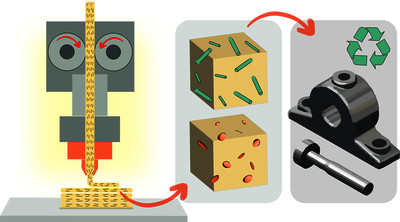Tóth, Csenge and Molnár, Kolos and Virág, Ábris Dávid (2025) Short fiber reinforcement in material extrusion 3D printing: A meta‐analysis review with insights into sustainable alternatives. POLYMER COMPOSITES. ISSN 0272-8397 (In Press)
|
Text
Polymer Composites - 2025 - Tóth.pdf - Published Version Available under License Creative Commons Attribution Non-commercial. Download (10MB) | Preview |
|
![[img]](https://real.mtak.hu/222586/2.hassmallThumbnailVersion/pc29850-toc-0001-m.jpg)
|
Text (graphical abstract)
pc29850-toc-0001-m.jpg - Published Version Available under License Creative Commons Attribution Non-commercial. Download (234kB) | Preview |
Abstract
Short fiber reinforcement is a key for improving the mechanical properties of thermoplastic composites produced by 3D printing. However, the strengthening potential of fibers is often under-utilized due to sub-optimal processing conditions. This meta-analysis review systematically evaluates the microstructural and mechanical properties of short fiber-reinforced composites, identifying key trends related to fiber fragmentation, fiber-matrix interactions, and property optimization. Our statistical analysis results show that fiber content and initial fiber length have minimal effect on the average remaining fiber length in the filament, which highlights that processing conditions are the primary control on fiber breakage. In addition, the fiber aspect ratio does not show a direct correlation with tensile strength, which can be due to insufficient fiber-matrix adhesion. Despite these drawbacks, the fibers still increase the tensile modulus by an average of 2.22 times and the flexural modulus by an average of 2.69 times. Analytical models for predicting mechanical properties are also presented, noting that while they provide valuable insights, time-consuming experimental validation is still required for accurate estimates. Finally, we provide insights into sustainable waste-derived fillers as potential alternatives to conventional fibers. Although their mechanical performance remains less predictable, surface treatment strategies and advanced multi-scale modeling techniques will be essential to establish structure–property relationships and to exploit their potential fully. Ultimately, waste-derived fillers hold significant promise for replacing raw material from primary sources, paving the way for more sustainable composite 3D printing.
| Item Type: | Article |
|---|---|
| Uncontrolled Keywords: | mechanical modeling, microstructure, short fiber composite, sustainable composites, waste fillers |
| Subjects: | T Technology / alkalmazott, műszaki tudományok > TJ Mechanical engineering and machinery / gépészmérnöki tudományok |
| Depositing User: | Dr. Tamás Tábi |
| Date Deposited: | 22 Aug 2025 06:35 |
| Last Modified: | 22 Aug 2025 06:35 |
| URI: | https://real.mtak.hu/id/eprint/222586 |
Actions (login required)
 |
Edit Item |




